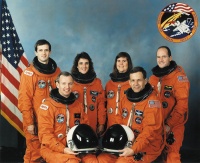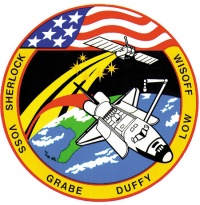STS-57
From The Space Library
 | |
| Organization | NASA-Office of Space Flight (United States) |
|---|---|
| Mission type | Engineering,Human Crew,Microgravity |
| Launch date | June 21, 1993 |
| Launch vehicle | Space Shuttle |
| Launch site | Cape Canaveral, United States |
| COSPAR ID | 1993-037A |
| Inclination | 28.45 degrees |
| Experiments | Here |
| Alternate Names | SPACEHAB 1/STS 57,22684 |
| Additional Information | Here |
| Telecommunications Information | Here |
| Data Collection | Here |
| Payload Mass Up | 8931 kg |
| Payload Mass Down | 13147.73 kg |
| Orbiter | Endeavour |
| Lift Off Mass | 2,052,935.91 kg |
| Orbiter Weight at Liftoff | 114,708.64 kg |
| Orbiter Weight at Landing | 111,090.91 kg |
| Landed | Concrete runway 33 at Kennedy Space Center, Fla. |
| Orbits of Earth | 155 |
| Orbital Altitude | 250 nautical miles (287 statute miles) |
Contents |
[edit] Crew
- Commander: Ronald J. Grabe
- Pilot: Brian J. Duffy
- Payload Commander: G. David Low
- Mission Specialist 1: Nancy J. Sherlock
- Mission Specialist 2: Peter J.K. "Jeff" Wisoff
- Mission Specialist 3: Janice E. Voss
- Mission Specialist 4:
- Mission Specialist 5:
- Payload Specialist 1:
- Payload Specialist 2:
ISS/Mir Crew Transport
[edit] Mission
STS 57 was the 56th shuttle mission and the fourth flight of the Endeavour orbiter. It carried for the first time the Spacehab research laboratory, designed for six experiments on material science and six biotechnology experiments. In addition, it conducted five experiments of interest to the Johnson Space Center, one experiment relatable to a future space station, and one designed to grow non-linear optical crystals. STS 57 retrieved the Eureca spacecraft that had been released during the STS 46 mission. During the course of the eight-day flight, the astronauts successfully conducted scores of biomedical and materials sciences experiments inside the pressurized SPACEHAB module. Two astronauts particpated in a spacewalk and the European Retrievable Carrier (EURECA) was retrieved by the crew and stowed inside Endeavour's payload bay. EURECA was deployed from the Shuttle Atlantis in the summer of 1992 and contains several experiments to study the longterm efects of exposure to microgravity. An improperly installed electrical connector on Endeavour's Remote Manipulator System (RMS) arm (installed 180 degrees off its correct position) prevented Eureca from recharging its batteries with orbiter power. A flight rule was requiring antenna stowage was waived and EURECA was lowered into the payload bay without latching its antenna. Mission Specialists David Low and Jeff Wisoff safely secured EURECA's dual antennas against the science satellite during the spacewalk performed on Friday. David Low was mounted an foot restraint on the end of Endeavour's robotic arm while Mission Specialist Nancy Sherlock positioned the arm so Low could gently push the arms against EURECA's latch mechanisms. Payload controllers then drove the latches to secure each antenna. The five-hour, 50 minute spacewalk completed STS-57 mission's primary goal of retrieving the EURECA science satellite. Afterwards, Low and Wisoff completed maneuvers for an abbreviated extravehicular activity (EVA) Detailed Test Objective using the robot arm. Activities associated with each of the areas of investigation -- mass handling, mass fine alignment and high torque -- were completed with both EVA crewmen taking turns on the robot arm. Low and Wisoff wrapped up their spacewalk and returned to Endeavour's airlock shortly before 3 p.m. Central. During the rest of the mission, the crew worked on experiments in the Spacehab module in the Shuttle's lower deck. These experiments included studying body posture, the spacecraft environment, crystal growth, metal alloys, wastewater recycling and the behavior of fluids. Among the experiments was an evaluation of maintenance equipment that may be used on Space Station Freedom. The diagnostic equipment portion of the Tools and Diagnostics System experiment was performed by Nancy Sherlock. Using electronics test instruments including an oscilloscope and electrical test meter, Sherlock conducted tests on a mock printed circuit board and communicated with ground controllers via computer messages on suggested repair procedures and their results. In addition, Brian Duffy and Jeff Wisoff ran experiments in transferring fluids in weightlessness without creating bubbles in the fluid. The experiment, called the Fluid Aquisition and Resupply Experiment, or FARE, studied filters and processes that may lead to methods of refueling spacecraft in orbit and transfers water between two foot-diameter transparent tanks on Endeavour's middeck, engineers can evaluate how the fluids behave while the shuttle's steering jets are fired for small maneuvers. Janice Voss worked on the Liquid Encapsulated Melt Zone, or LEMZ, experiment which uses a process called floating zone crystal growth. The low-gravity conditions of space flight permit large crystals to be grown in space. Ron Grabe, Brian Duffy and Janice Voss participated in the Neutral Body Position study. Flight surgeons have noted on previous flights that the body's basic posture changes while in microgravity. This postural change, sometimes called the "zero-g crouch," is in addition to the one- to two-inch lengthening of the spine during space missions. To better document this phenomenon over the duration of a space mission, still and video p hotography of crew members in a relaxed position are taken early and late in the mission. Researchers will include these findings in the specifications for design of future spacecraft to make work stations and living areas efficient and more comfortable for astronauts. Nancy Sherlock stepped through the electronics procedures portion of the Human Factors Assessment this morning. She set up a work platform then hooked up a notebook computer and went through a simulated computer procedure for a space station propulsion system. On 6/28/93, Nancy Sherlock performed an impromptu plumbing job on the Environmental Control Systems Flight Experiment, a study of wastewater purification equipment that may be used aboard future spacecraft. EFE uses a mixture of water and potassium idodide to simulate wastewater. The solution is pumped through a series of filters to purify it. During the flight, experimenters have seen a reduced flow of water through the device and opted to perform the maintenance procedure. Sherlock loosened a fitting on one water line inside the experiment, wrapped the loose fitting with an absorbent diaper, and, using a laptop computer onboard, turned a pump on the experiment into reverse for about 20 minutes in an attempt to flush out the clog. Sherlock then retightened the fitting and put the experiment back into normal operation for ground experimenters, who will now spend about an hour and a half watching it run to see if the clog has been cleared. The orbiter completed 155 orbits and had a total duration of 9 days, 23 hours, 44 minutes, and 54 seconds.
[edit] EVA
Extravehicular Activity (EVA) conducted by David Low and Jeff Wisoff, 5 hours, 50 minutes. Low and Wisoff conducted tests to refine procedures being developed to service the Hubble Space Telescope and to prepare for construction of the International Space Station.
[edit] Payload
SPACEHAB 01; retrieval of European Retrievable Carrier (EURECA) Satellite; Superfluid Helium On-Orbit Transfer (SHOOT); Consortium for Materials Development in Space Complex Autonomous Payload (CONCAP)-IV; Fluid Acquisition and Resupply Experiment (FARE); Shuttle Amateur Radio Experiment (SAREX) II; Air Force Maui Optical Site (AMOS); GAS bridge assembly with 12 getaway special payloads
[edit] Books about the Space Shuttle Program
Buy This Book Click here |
Buy This Book here |
Buy This Book Click here |
Buy This Book Click here |





